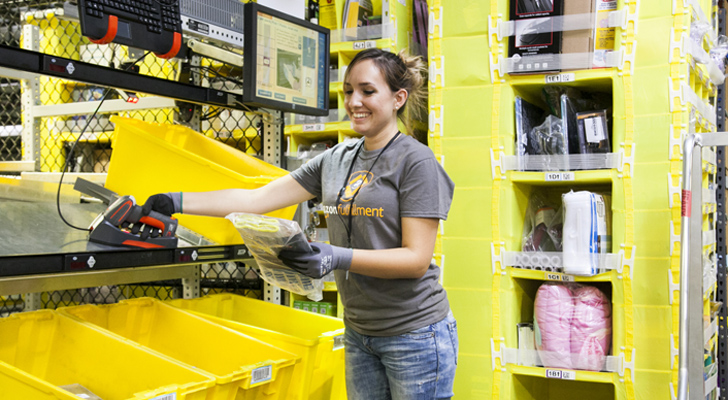Almost a year ago I raised a red flag regarding the sheer number of operations Amazon.com (NASDAQ:AMZN) was dragging under its umbrella. Though they all expanded the company’s web of influence, it can be difficult (and expensive) to do so many things as well as they need to be done. Still, Amazon stock grew undeterred.
It was a premise not terribly well accepted by fans and followers of Amazon stock, who by the way, enjoyed the fact that AMZN stock continued to rally despite my caution. Although it’s been rocked since late September, that pullback’s got more to do with the broad market tide than the company hitting the wall I described.
Nonetheless, we’ve continued to see the war stories unfurl that point to size-related problems.
From Friend to Foe
Don’t misread the message. Amazon can achieve an economy of scale with its e-commerce arm, as well as with Amazon Web Services.
Indeed, for the first time in. well, ever, we’re starting to see profit margins — a percentage of sales — widen as Amazon grows its top line. That’s the ingredient that’s been missing with the company’s attack on brick-and-mortar names like Walmart (NYSE:WMT) or Best Buy (NYSE:BBY).
In other ways, however, the ecommerce giant is flashing more hints that it’s struggling to effectively add all the bolt-on operations that ultimately allow it to sell more merchandise.
Case in point: The company’s tenuous relationship with Instacart will soon be severed, as the shopping and delivery service aims to more closely align itself with competitors to Amazon’s Whole Foods.
The end of this one relationship isn’t devastating. Amazon doesn’t need Instacart because it can do the same for itself, and Instacart is more than happy to walk away from the increasingly unfruitful partnership.
But, in that partnerships are, or were, a critical part of the company’s MO, Amazon’s sheer size and willingness to do anything is finally causing the company to step on toes.
Third party athletic apparel sellers and even the manufacturers themselves aren’t thrilled with the prospect of Amazon wading into private-label athletic wear, and now Nike (NYSE:NKE) is turning up the heat on driving its own sales through Nike.com as a means of circumventing Amazon.com.
As of October Amazon makes and markets its own mattress, straining a long-standing relationship with mattress outfit Casper, which had sold its products via Amazon.com for years. And, as was noted (but needs reiterating), Instacart is now working diligently to make sure rivals to Whole Foods succeed.
Slowly but surely, all of these displaced partners are finding ways to collectively compete with the king of ecommerce after they helped make Amazon what it is today.
Other Signs of Trouble
The more in-house and private-label design work Amazon does, the more often Amazon stock holders are going to hear about patent infringement suits like the one Williams-Sonoma (NYSE:WSM) just filed.
Williams-Sonoma has a point; the two chairs in question look an awfully lot alike. But, to be fair, it was likely only an inadvertent mistake. Not knowing doesn’t absolve Amazon of its responsibility or liability though. Moreover, it’s apt to only be a matter of time before more of its home-grown goods look like knockoffs. It’s difficult to keep tabs on all potential patent and design conflicts.
Arguably the bigger and more alarming sign of recent growing pains involves Amazon’s effort to build an army of independently-contracted delivery drivers.
The premise sounded like a win/win when first unveiled a couple of years ago (and has since been duplicated in slightly different formats).
Amazon’s business is booming, and delivery services like FedEx and the U.S. Postal Service are just expensive middlemen that get in the way. Amazon would be better off doing its own deliveries, and independent contractors willing to tackle the task stood to benefit from Amazon’s ever-growing business.
As it turns out, however, those contractors should have been skeptical of the terms of the deal. Drivers claim they’ve been worked like employees, but only paid like contractors; pay that is capped regardless of the amount of work done. Multiple lawsuits on the matter are in the works.
It shouldn’t be a terribly surprising. Amazon.com has to contain costs in order to keep its prices low. But, underpaying workers, and the same complaint has been often made by warehouse workers, isn’t a sustainable solution. Sooner or later, workers who feel they get paid too little for too much output revolt, leave or slack off.
Yet, this sort of aggressive cost containment remains a big part of the Amazon business model.
Bottom Line for Amazon Stock
And as it turns out, we’re already starting to see cracks form in the company’s business, largely stemming from the company’s sheer size and number of moving parts.
In November, despite the acquisition and Amazon-ing of Whole Foods Market, Walmart quietly eclipsed Amazon.com as the nation’s preferred online grocer. Conversely, UBS just reported that the number of Prime members who shopped Amazon.com for groceries at least once a month fell from 2017’s 17% to 12% in 2018.
What gives?
Arguably, in its effort to be all things to all people and do all things possible to get and keep people in the Amazon ecosystem (by doing it all for dirt-cheap prices), Amazon is finally starting to show some wear and tear. Details are being missed. Compromises are being made.
It’s not a reason in and of itself to shed Amazon stock. The company could comfortably coast for a few more years before the impact of its size and increasing complexity finally catches up with it and creates more severe headaches.
On the other hand, if you’re asking yourself “should I buy Amazon stock today?,” the answer is hardly a resounding “Yes!” As it turns out, Amazon isn’t bulletproof after all. The bigger it gets, the more vulnerable it becomes.
As of this writing, James Brumley did not hold a position in any of the aforementioned securities. You can follow him on Twitter, at @jbrumley.

